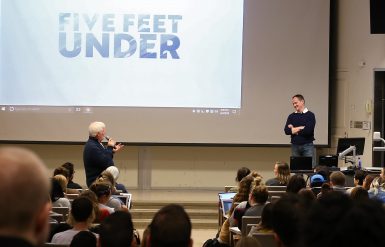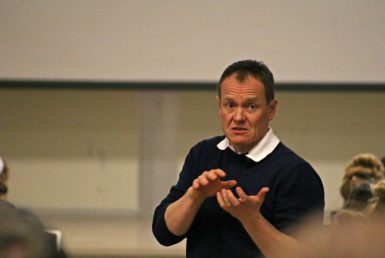Bjorn Nord discusses narrative writing with Behind the Prize students

When Bjorn Nord read a small Bergens Tiende article about Adina Lange, who was rescued after being caught in an avalanche in March 2017, he knew he wanted to write a larger piece about it. Usually people die trapped in the snow for 30 minutes, but she survived for over four hours until volunteers rescued her. How? At the time of the rescue, Norway was about to hold an election and the world was in a debate over values. Nord thought about how he could connect the incident to a larger narrative.
“When I do stories, I want to put it into the world we live in,” Nord said. “I want to lift it up to a higher level, give it a meaning.”
He decided to focus on the volunteer rescue workers and show the world that taking care of each other is important in Norway, and “Five Feet Under” became a narrative story about those subjects.
Nord is one of Norway’s top reporters and has been a journalist since he was 16, starting out as a freelance soccer reporter on the weekends. He now writes for Bergens Tiende, Norway’s largest newspaper outside Oslo. Media School Professor of Practice Thomas French met Nord at a Poynter seminar several years ago and the two struck up a friendship. They’ve kept in touch, and when French learned about the avalanche story Nord was working on, French invited him in to talk to his Behind the Prize class on Monday, April 2.
“I read that ending, and it was so affirming without being sentimental. I have to tell you after half a century of reading newspapers that is very difficult to achieve,” French said. “If you write something life-affirming, it often reads like a lifetime movie, it reads cliché. There was nothing cliché to this story.”
Carly Shoneman, a Media freshman specializing in advertising and PR in French’s class, said that Nord has been her favorite speaker in the class to date.
“I am amazed he traveled all this way to speak to us,” Shoneman said. “I especially loved the visual elements in this story. They made it really special.”
As readers scroll through the story online, they see illustrations by Steffen Øie, starting with snowy mountains and then a dark screen and outline of Lange, simulating how deep she was buried under the snow. Bergens Tiende hired a game designer to add effects like that throughout the story online. These effects give readers a feeling of being right alongside the characters and a reward for staying with the story until the end. This was the first time Nord had ever done a story with animations and he said he was very inspired by all the ways stories could be told digitally.
“When she was beneath the snow, it was totally dark. I wanted to create the feeling she had,” Nord said. “I wanted the readers to feel a similar claustrophobia, so that was one of the reasons I wanted to create this difference.”

Because the story was dramatic, creating tension in the writing was important. One of the ways Nord accomplished this was to include sentences of anxiety in every paragraph, which in turn gave readers questions they want answered at the end of each section. It was particularly important to create a feeling of unease in the story’s three-sentence opening to draw readers in.
“I paid particular attention to how I use sentences in this story because it was so dramatic,” Nord said. “It was so filled with drama, and I wanted to give it tempo and I wanted to make it clear when it was Adina under the snow.”
Adina’s story is very powerful, particularly when read from her father’s perspective. As a father of two daughters, Nord told the students that it is important for him to not separate himself from the empathy he feels while writing the story. It is a part of his voice when he writes, and it’s an important part of narrative journalism. Stories that evoke emotion can create changes in systems, he said, and in people’s’ hearts.
“I have never told the best story,” Nord said. “The best story is around the corner, it might be just around the corner. You can always do better, everyday.”

